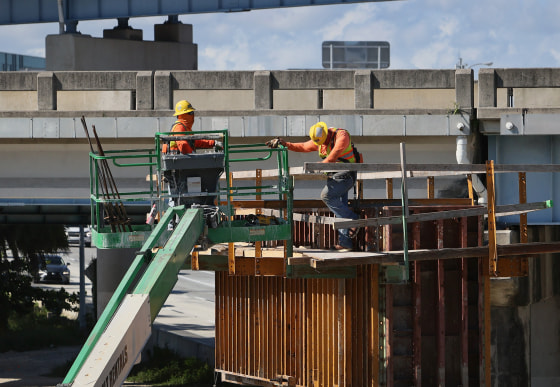A new study finds that both the labor market and the broader economy will become increasingly anchored by a young, dynamic population of Latino workers — a finding that has implications for everything from employers’ investment decisions to local economic diversification, to the functioning of critical social safety net programs.
According to the 2021 U.S. Latino GDP Report, Latinos have contributed close to three-quarters of the entire labor force expansion that has taken place since the Great Recession.
The report was released this week during the third annual L’ATTITUDE conference in San Diego, California, which highlights the economic and social contributions of U.S. Latinos.
“Given the retirement of the Boomers and that the Boomers are much more overwhelmingly white, certainly Latinos will play a greater role in the economy. I don’t think there’s any question about that. But their role might evolve over time,” said Harry Holzer, professor of public policy at Georgetown University.
There are over 60 million Hispanics, 41 million Blacks, nearly 19 million Asian-Americans, and 596 thousand Native Hawaiian and Pacific Islanders. The total White population is still larger than each of the four nearest racial or ethnic groups combined at over 328 million, according to Census data.
But the balance is rapidly changing. The Latino and Hispanic population rose 70 percent from 2000 to 2019. Only Asian-Americans grew faster, increasing 81 percent. The Black population grew 20 percent and the White population grew just 1 percent.
The American Latino population’s young age, high labor force participation and rapid increases in education make them a crucial segment of the labor market on whom employers will increasingly come to rely, said Rodrigo Dominguez-Villegas, director of research for the Latino Policy & Politics Initiative at the University of California, Los Angeles.
“The workforce in the U.S. right now is going through a little bit of a transformation. The non-Latino part of the workforce is aging and retiring out of the workforce,” he said. In 2019, the median age of Latinos in the U.S. was just under 29 years old, compared to nearly 41 years old for non-Latinos.
Younger Latinos are not only contributing more to the workforce but also to the nation's entitlement programs by paying into programs like Social Security, Medicare, Medicaid, and many Veterans' Administration programs.
“Latino workers are going to be essential in maintaining the labor force that supports all of those people who are retiring,” Dominguez-Villegas said.
Slightly less than one in five people currently living in the U.S. identify as Hispanic or Latino. But they represent the second fastest-growing demographic. Just over half of the U.S.’s population growth measured by the 2020 Census was due to an increasing population of Hispanic or Latino residents, and the Latino population in the U.S. grew by nearly 25 percent over the past decade.
While the overall labor force participation rate has struggled to break out of a narrow band around 61.7 percent, the labor force participation rate for Americans of Hispanic or Latino descent was 65.6 percent in August, according to data from the U.S. Bureau of Data Statistics. In 2019, Latino labor force participation was 68.2 percent in 2019, 5.5 percentage points higher than the rate of non-Latinos.
Hispanic unemployment currently is higher than the overall rate, at 6.4 percent compared to 5.2 percent for the entire population — although that 6.4 percent was a marked improvement from this group’s 10.5 percent unemployment rate a year earlier.
The plunge in service-sector jobs, particularly in leisure and hospitality, hit Latinos hard when the pandemic struck, with this population’s unemployment rate soaring to 18.9 percent in April 2020, higher than any other ethnic group.
The U.S. Latino GDP Report finds that education and healthcare, professional and business services, and finance and real estate are the economic sectors in which Latinos contribute the highest dollar values, respectively, to U.S. economic output. “It really shows that the Latino GDP is much more diverse and broader than people would expect,” Dominguez-Villegas said.
The sectors where Latinos are currently represented most heavily in the workforce include farming, construction, and food service. But this is changing as more members of the current generation of new immigrants and first-generation Americans put down roots, and invest in homes, businesses and higher education.
“We’re seeing a lot of young people entering college and graduating from college, so that’s going to change the sector distribution of the Latino workforce,” Dominguez-Villegas said.
The U.S. Latino GDP Report said that, between 2010 and 2019, the number of Latinos who earned bachelor’s degrees grew at a rate nearly three times that of non-Latinos. “Their education attainment will rise and the role they play in the economy will evolve. And as they get more education, they get more mobile,” Holzer said.
“To the extent that it improves, you'll see some growth in professional managerial, technical jobs,” Holzer said, as well as migration to better-paying, higher-status jobs in the fields where many now fill entry-level positions.
As important as Latinos are to the nation’s worker base now, they will become even more critical in the future, Dominguez-Villegas said, pointing out that the entitlement programs that are a bedrock of retirees’ physical and financial health are becoming depleted.
“Medicare and Social Security are under pressure,” he said. “The solvency of both these programs is directly dependent on the payroll contributions of a largely Latino current and future workforce. Latino workers are going to be essential in maintaining the labor force that supports all of those people who are retiring.”
